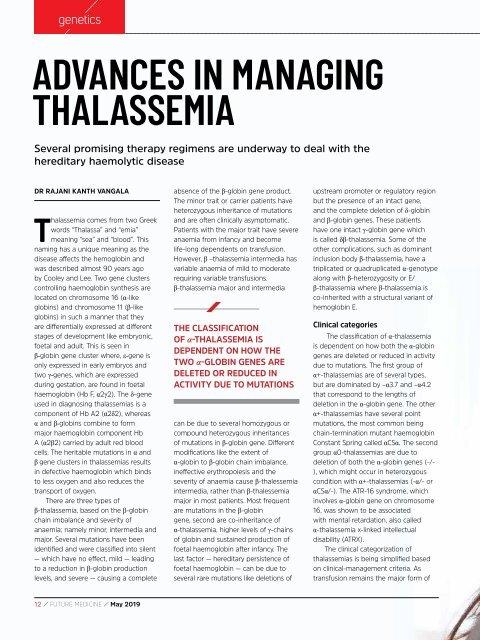may edition file
Create successful ePaper yourself
Turn your PDF publications into a flip-book with our unique Google optimized e-Paper software.
genetics<br />
ADVANCES IN MANAGING<br />
THALASSEMIA<br />
Several promising therapy regimens are underway to deal with the<br />
hereditary haemolytic disease<br />
DR RAJANI KANTH VANGALA<br />
Thalassemia comes from two Greek<br />
words “Thalassa” and “emia”<br />
meaning “sea” and “blood”. This<br />
naming has a unique meaning as the<br />
disease affects the hemoglobin and<br />
was described almost 90 years ago<br />
by Cooley and Lee. Two gene clusters<br />
controlling haemoglobin synthesis are<br />
located on chromosome 16 (α-like<br />
globins) and chromosome 11 (β-like<br />
globins) in such a manner that they<br />
are differentially expressed at different<br />
stages of development like embryonic,<br />
foetal and adult. This is seen in<br />
β-globin gene cluster where, ε-gene is<br />
only expressed in early embryos and<br />
two γ-genes, which are expressed<br />
during gestation, are found in foetal<br />
haemoglobin (Hb F, α2γ2). The δ-gene<br />
used in diagnosing thalassemias is a<br />
component of Hb A2 (α2δ2), whereas<br />
α and β-globins combine to form<br />
major haemoglobin component Hb<br />
A (α2β2) carried by adult red blood<br />
cells. The heritable mutations in α and<br />
β gene clusters in thalassemias results<br />
in defective haemoglobin which binds<br />
to less oxygen and also reduces the<br />
transport of oxygen.<br />
There are three types of<br />
β-thalassemia, based on the β-globin<br />
chain imbalance and severity of<br />
anaemia; namely minor, intermedia and<br />
major. Several mutations have been<br />
identified and were classified into silent<br />
— which have no effect, mild — leading<br />
to a reduction in β-globin production<br />
levels, and severe — causing a complete<br />
absence of the β-globin gene product.<br />
The minor trait or carrier patients have<br />
heterozygous inheritance of mutations<br />
and are often clinically asymptomatic.<br />
Patients with the major trait have severe<br />
anaemia from infancy and become<br />
life-long dependents on transfusion.<br />
However, β –thalassemia intermedia has<br />
variable anaemia of mild to moderate<br />
requiring variable transfusions.<br />
β-thalassemia major and intermedia<br />
THE CLASSIFICATION<br />
OF α-THALASSEMIA IS<br />
DEPENDENT ON HOW THE<br />
TWO α-GLOBIN GENES ARE<br />
DELETED OR REDUCED IN<br />
ACTIVITY DUE TO MUTATIONS<br />
can be due to several homozygous or<br />
compound heterozygous inheritances<br />
of mutations in β-globin gene. Different<br />
modifications like the extent of<br />
α-globin to β-globin chain imbalance,<br />
ineffective erythropoiesis and the<br />
severity of anaemia cause β-thalessemia<br />
intermedia, rather than β-thalessemia<br />
major in most patients. Most frequent<br />
are mutations in the β-globin<br />
gene, second are co-inheritance of<br />
α-thalassemia, higher levels of γ-chains<br />
of globin and sustained production of<br />
foetal haemoglobin after infancy. The<br />
last factor — hereditary persistence of<br />
foetal haemoglobin — can be due to<br />
several rare mutations like deletions of<br />
upstream promoter or regulatory region<br />
but the presence of an intact gene,<br />
and the complete deletion of δ-globin<br />
and β-globin genes. These patients<br />
have one intact γ-globin gene which<br />
is called δβ-thalassemia. Some of the<br />
other complications, such as dominant<br />
inclusion body β-thalassemia, have a<br />
triplicated or quadruplicated α-genotype<br />
along with β-heterozygosity or E/<br />
β-thalassemia where β-thalassemia is<br />
co-inherited with a structural variant of<br />
hemoglobin E.<br />
Clinical categories<br />
The classification of α-thalassemia<br />
is dependent on how both the α-globin<br />
genes are deleted or reduced in activity<br />
due to mutations. The first group of<br />
α+-thalassemias are of several types,<br />
but are dominated by –α3.7 and –α4.2<br />
that correspond to the lengths of<br />
deletion in the α-globin gene. The other<br />
α+-thalassemias have several point<br />
mutations, the most common being<br />
chain-termination mutant haemoglobin<br />
Constant Spring called αCSα. The second<br />
group α0-thalassemias are due to<br />
deletion of both the α-globin genes (-/-<br />
), which might occur in heterozygous<br />
condition with α+-thalassemias (-α/- or<br />
αCSα/-). The ATR-16 syndrome, which<br />
involves α-globin gene on chromosome<br />
16, was shown to be associated<br />
with mental retardation, also called<br />
α-thalassemia x-linked intellectual<br />
disability (ATRX).<br />
The clinical categorization of<br />
thalassemias is being simplified based<br />
on clinical-management criteria. As<br />
transfusion remains the major form of<br />
12 / FUTURE MEDICINE / May 2019


















